|
|||||||
|
|
|
 |
|
|
Strumenti |
|
|
#181 |
|
Senior Member
Iscritto dal: Mar 2002
Città: Treviso
Messaggi: 911
|
noto solo ora...
quante accidenti di missioni ha fatto quel B-52??? |
|
|

|
|
|
#182 | |
|
Senior Member
Iscritto dal: Nov 2003
Città: Utopia Planitia
Messaggi: 3875
|
Quote:
__________________

|
|
|
|

|
|
|
#183 | |
|
Senior Member
Iscritto dal: Apr 2006
Messaggi: 1464
|
Quote:
|
|
|
|

|
|
|
#184 |
|
Senior Member
Iscritto dal: Nov 2001
Città: Padova
Messaggi: 1638
|
SFN:
Russian rocket rolls to pad with space station module BY STEPHEN CLARK SPACEFLIGHT NOW Posted: November 8, 2009  A Soyuz rocket topped with the new Poisk module for the International Space Station took a train ride to historic Launch Pad No. 1 at the Baikonur Cosmodrome on Sunday morning, two days before the new component begins its trek to the orbiting complex. http://www.spaceflightnow.com/statio...091108mrmroll/
__________________
Cosmos Pure | Core i7 860 | P7P55D-E Deluxe | 16GB DDR3 Vengeance | HD5850 | 2x850PRO 256GB | 2xRE3 250GB | 2xSpinPoint F3 1TB |
|
|

|
|
|
#185 |
|
Senior Member
Iscritto dal: Nov 2001
Città: Padova
Messaggi: 1638
|
SFN:
Poisk launches to add new room for space station BY STEPHEN CLARK SPACEFLIGHT NOW Posted: November 10, 2009 A Soyuz rocket blasted off from the plains of Kazakhstan Tuesday with the International Space Station's newest addition, a module doubling as a docking port for visiting spacecraft and an airlock for spacewalking astronauts.  The 168-foot-tall booster roared away from Launch Pad No. 1 at the Baikonur Cosmodrome at 1422 GMT (9:22 a.m. EST) Tuesday, or just after nightfall Tuesday night in Kazakhstan. The venerable Soyuz, flying for the 1,750th time in its various configurations, launched into mostly clear skies, fading from view of ground cameras as it shed four strap-on boosters. The three-stage rocket delivered its payload, the Poisk docking compartment, to a low-altitude injection orbit about nine minutes after liftoff. Poisk, which means "search" or "explore" in Russian, is attached to the service module of a Russian Progress resupply ship, providing electrical power and propulsion for the spacecraft during its two-day journey to the space station. http://www.spaceflightnow.com/statio...1110mrmlaunch/
__________________
Cosmos Pure | Core i7 860 | P7P55D-E Deluxe | 16GB DDR3 Vengeance | HD5850 | 2x850PRO 256GB | 2xRE3 250GB | 2xSpinPoint F3 1TB |
|
|

|
|
|
#186 | |
|
Senior Member
Iscritto dal: Apr 2006
Messaggi: 1464
|
Quote:
|
|
|
|

|
|
|
#187 | |
|
Senior Member
Iscritto dal: Apr 2006
Messaggi: 1464
|
Foto esclusiva delle armi in dotazione all'equipaggio della ISS per combattere eventuali invasioni aliene:
 Quote:
|
|
|
|

|
|
|
#188 |
|
Senior Member
Iscritto dal: Sep 2006
Messaggi: 7030
|
In before Giacobbo prende la stringa "Also, the device can be used for martial arts training – to be prepared for an alien attack on the Russian segment of the ISS." e dice che i russi si preparano a affrontare un'invasione aliena
__________________

|
|
|

|
|
|
#189 |
|
Senior Member
Iscritto dal: Nov 2001
Città: Padova
Messaggi: 1638
|
SFN:
NASA assumes ownership of next space station module BY STEPHEN CLARK SPACEFLIGHT NOW Posted: November 21, 2009 The European Space Agency formally handed over ownership of the Tranquility module to NASA on Friday, two-and-a-half months before the connecting node's February launch on shuttle Endeavour. 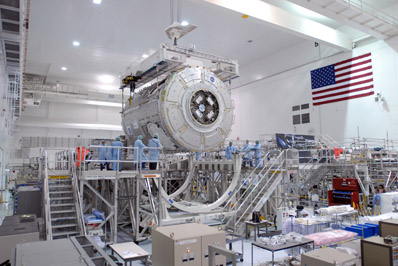 The exchange occurred in a ceremony inside the Space Station Processing Facility at Kennedy Space Center. ESA space station program manager Bernardo Pitto signed over control of the module to Mike Suffredini, the NASA station program manager. "We're very proud to accept this module," Suffredini said. Tranquility and a small windowed room called Cupola will be launched together on Endeavour's STS-130 mission, currently scheduled for liftoff Feb. 4. The modules have a combined launch mass of almost 30,000 pounds. The modules are among the last major components of the complex to be prepared for launch inside the cavernous processing building. The facility has been home to U.S., European and Japanese modules before their launch to the station. "It's sort of a bittersweet moment, as we are tailing off of assembly," Suffredini said. "As we into operations, facilities like this one will be more barren as we put things together on orbit." "There's no room to be sentimental," Patti said. "It would actually be worse if everything was still here." Built by Thales Alenia Space in Italy, Tranquility measures nearly 15 feet in diameter and almost 23 feet long. The barrel-shaped module was delivered to KSC in May. ESA and the Italian Space Agency oversaw the construction in a barter arrangement with NASA. The trade, which also included the building of the Harmony module, was in exchange for a space shuttle launch for Europe's Columbus laboratory module in 2008. Equipment in Tranquility will help control the station's atmosphere, generate oxygen and recycle water. The COLBERT treadmill and a toilet will also be permanently located inside the module. Tranquility allows astronauts to move most of the hardware from the Destiny laboratory, freeing up more space for research. 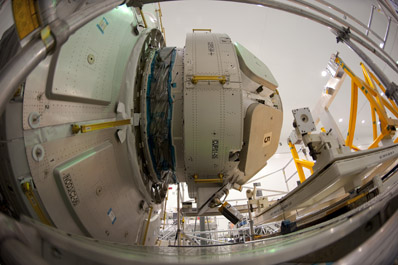 The Cupola includes seven windows to give station crew members a panoramic view for Earth observation and robotics operations, including capturing incoming cargo vehicles for berthing to the outpost. Suffredini said Tranquility will be attached to the port side of the Node 1 module, called Unity. The Cupola will eventually be attached to the down-facing side of Tranquility. A small module connector named Pressurized Mating Adapter 3 will be repositioned to the end of Tranquility, according to Suffredini. "We are trying to optimize its location, based on where other modules ultimately end up," Suffredini said. Tranquility was originally supposed to be located on the nadir, or Earth-facing, port on Unity. But that would cause clearance issues with docking Russian spacecraft on the nearby Zarya module. A Russian stowage module was originally expected to launch by the time Tranquility arrived, providing an extension to clear the docking clearance concerns. The Russian component now will not launch until 2011. http://www.spaceflightnow.com/news/n0911/21tranquility/
__________________
Cosmos Pure | Core i7 860 | P7P55D-E Deluxe | 16GB DDR3 Vengeance | HD5850 | 2x850PRO 256GB | 2xRE3 250GB | 2xSpinPoint F3 1TB |
|
|

|
|
|
#190 | |
|
Senior Member
Iscritto dal: Apr 2006
Messaggi: 1464
|
 Quote:
|
|
|
|

|
|
|
#191 | |
|
Senior Member
Iscritto dal: Apr 2006
Messaggi: 1464
|
Una nuova tecnologia per rifornire di propellente satelliti non progettati per permettere questa operazione potrebbe essere testata sulla ISS:
Quote:
|
|
|
|

|
|
|
#192 | |
|
Senior Member
Iscritto dal: Nov 2003
Città: Utopia Planitia
Messaggi: 3875
|
Quote:
__________________

|
|
|
|

|
|
|
#193 | |
|
Senior Member
Iscritto dal: Apr 2006
Messaggi: 1464
|
Ora gli astronauti sulla ISS possono accedere direttamente a internet:
Quote:
|
|
|
|

|
|
|
#194 |
|
Senior Member
Iscritto dal: Nov 2001
Città: Padova
Messaggi: 1638
|
Con l'installazione del Nodo 3 "Tranquility" e della Cuploa, la costruzione il segmento americano della ISS (e quindi di gran parte della stazione) è finalmente completata!
SFN: Crew praises 'phenomenal' view from station's cupola BY WILLIAM HARWOOD STORY WRITTEN FOR CBS NEWS "SPACE PLACE" & USED WITH PERMISSION Posted: February 19, 2010 Space station commander Jeffrey Williams and George Zamka, commander of the shuttle Endeavour, cut a ceremonial red ribbon late Thursday and declared the new cupola observation deck "open for business."  http://spaceflightnow.com/shuttle/st...12/index2.html
__________________
Cosmos Pure | Core i7 860 | P7P55D-E Deluxe | 16GB DDR3 Vengeance | HD5850 | 2x850PRO 256GB | 2xRE3 250GB | 2xSpinPoint F3 1TB |
|
|

|
|
|
#195 |
|
Senior Member
Iscritto dal: Nov 2001
Città: Padova
Messaggi: 1638
|
Un problema sul computer primario (C&C No. 1) di controllo della ISS ha causato un'interruzione di circa 10 minuti nelle comunicazioni (banda S) e nel donwlink della telemetria. Automaticamente, come previsto, un secondo computer ha assunto il controllo e ripristinato le comunicazioni.
Attualmente il C&C No. 3 sta operando da "prime computer", il No. 2 è in "backup position" e il No. 1 (quello che è "crashato") è in standy-by. SFN: Space station computer fails BY WILLIAM HARWOOD STORY WRITTEN FOR CBS NEWS "SPACE PLACE" & USED WITH PERMISSION Posted: February 21, 2010 A central computer failure aboard the International Space Station early today briefly knocked the lab complex out of contact with mission control, but a backup computer took over as programmed, officials said, and communications were restored. Engineers are investigating the failure. "The team is on console working through a fault tree to fully recover systems on board the station, which has suffered a failure of the primary command and control computer," said NASA commentator Pat Ryan. "Just before 9 a.m. EST "the team here in Houston lost S-band communications with the International Space Station. There was an indication that the primary C&C went down. Expedition 22 commander Jeff Williams called down when the station moved back into communications range at 8:55 (Central time) this morning and confirmed that the station had had a primary C&C failure. One of the three command and control computers, he reports, is hard failed. C&C No. 3 is now operating as the prime computer and No. 2 is currently in the backup position ready to take over for No. 3 if there is any difficulty there." During normal operations, one of the three C&C computers, known as a multiplexer/demultiplexer, operates as the "prime" machine, allowing station astronauts and ground controllers to send commands to various systems and providing critical telemetry. A second C&C computer operates in backup mode, ready to take over if the prime computer suffers a problem, and the third machine operates in standby in a domino-like software architecture. The computer system is critical to all aspects of space station operation. "At this point there is still no definitive answer as to what caused the problem, but the communications with the station have been returned," Ryan said. "For the crew members themselves, today was scheduled to be an off-duty day. They've been awake since midnight Houston time and had their only real task on the schedule, the weekly housecleaning, early in the day. So the systems on orbit are working in good shape with the exception of that failed command and control computer. But the backup and the backup's backup are operating just fine." He said the space station's systems are "stable at this time and there's no issue for the safety of the crew members." http://spaceflightnow.com/shuttle/st...21isscomputer/
__________________
Cosmos Pure | Core i7 860 | P7P55D-E Deluxe | 16GB DDR3 Vengeance | HD5850 | 2x850PRO 256GB | 2xRE3 250GB | 2xSpinPoint F3 1TB |
|
|

|
|
|
#196 | |
|
Senior Member
Iscritto dal: Mar 2002
Città: Treviso
Messaggi: 911
|
ISS ai raggi X
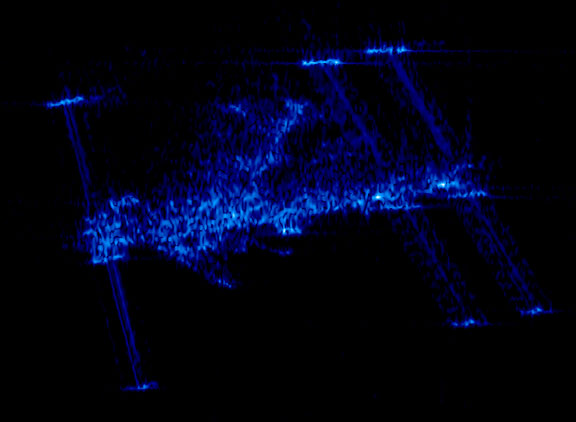 Quote:
|
|
|
|

|
|
|
#197 |
|
Bannato
Iscritto dal: Jun 2010
Messaggi: 93
|
|
|
|

|
|
|
#198 |
|
Bannato
Iscritto dal: Jan 2008
Messaggi: 140
|
|
|
|

|
|
|
#199 | |
|
Bannato
Iscritto dal: Jun 2010
Messaggi: 93
|
Quote:
|
|
|
|

|
|
|
#200 |
|
Senior Member
Iscritto dal: Nov 2001
Città: Padova
Messaggi: 1638
|
SFN:
Japan dispatches delivery mission to space station BY STEPHEN CLARK SPACEFLIGHT NOW Posted: January 22, 2011 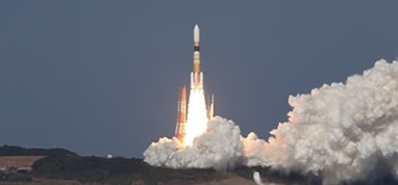 LOS ANGELES -- Japan successfully launched a robotic spaceship Saturday with supplies to stock the International Space Station with scientific gear, spare parts and provisions for the lab's six-person crew. The 35,000-pound orbital freighter blasted off aboard an H-2B rocket at 0537:57 GMT (12:37:57 a.m. EST) from Launch Pad No. 2 at the Tanegashima Space Center, an island base at the southern tip of Japan. The 186-foot-tall rocket soared into a mostly clear sky, breaking the sound barrier about a minute after setting off from its seaside launch pad. Four solid rocket boosters jettisoned two minutes into the flight, and the launcher's twin first stage main engines cut off less than four minutes later. A hydrogen-fueled second stage placed the H-2 Transfer Vehicle in orbit and deployed the payload 15 minutes after leaving Earth. The rocket was aiming for an orbit between 124 miles and 186 miles high with an inclination angle of 51.6 degrees to the equator. The rocket's actual orbital parameters were not immediately available, but a NASA spokesperson reported the launch was successful and said the HTV was transmitting data back to Japanese engineers in Tsukuba, a scientific hub just outside of Tokyo. "The launch vehicle flew smoothly, and, at about 15 minutes and 13 seconds after liftoff, the separation of the Kounotori 2 was confirmed," the Japan Aerospace Exploration Agency said in a written statement. Japan is calling the spacecraft Kounotori 2, which means white stork. JAXA confirmed the craft was controlling its orientation in space and activating key systems in the moments after reaching orbit. The launch was delayed two days by bad weather earlier this week. Saturday's mission is the second time Japan has launched the H-2B rocket and HTV cargo ship. JAXA and Mitsubishi Heavy Industries developed both vehicles as part of their contribution to the space station program. NASA reserves room on HTV missions for U.S. equipment as part of a barter agreement in return for the space shuttle's launch of Japan's Kibo module, the station's largest laboratory. The U.S. space agency provided 4,840 pounds of cargo for the HTV flight, including nearly 2,000 pounds of unpressurized gear comprising two large spare units mounted on the craft's exposed module. Stretching 33 feet long and 14 feet wide, the unmanned cargo vessel is carrying more equipment on this flight than on its first mission in 2009. Its total cargo load amounts to nearly 8,500 pounds, according to NASA. 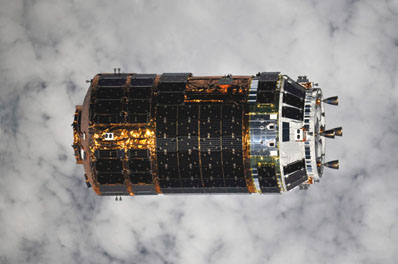 The debut HTV flight had extra batteries and propellant for several key demonstrations before approaching the space station. Those have been removed from this mission. Japanese engineers optimized the interior of the spacecraft, relocating ventilation ducts and lights to free up space for more cargo. Another change allowed the HTV to carry more bags of small internal logistics items, according to JAXA. Designers also modified navigation and rendezvous software used in the HTV's flight in space. The HTV features 57 solar panels arranged on the exterior of the ship for power production. The forward end of the craft is called the pressurized logistics carrier and the mid-section contains unpressurized cargo. The back end of the HTV is the service module housing avionics and propulsion systems. Japan is building five more HTVs for launch about once per year through about 2016. The next flight is expected in early 2012. Kounotori 2 will fire engines early Saturday to raise its orbit and set a course to approach the International Space Station. A further series of maneuvers over the next four days will set the stage for the ship's arrival at the complex early Thursday. Four main engines and 28 maneuvering thrusters will fine-tune the HTV's rendezvous with the station. The jets are wired to two redundant control strings. The engine burns will place the HTV in position for its laser-guided navigation system to guide the ship to a capture point about 30 feet directly beneath the outpost's Kibo module. Astronauts Cady Coleman and Paolo Nespoli will grapple the barrel-shaped spacecraft with the lab's robot arm and attach the ship to the Earth-facing port of the Harmony module. Plans call for the HTV to be robotically captured at 1144 GMT (6:44 a.m. EST) Thursday. It should be firmly bolted to the station a few hours later. In early February, the station crew will transfer two NASA payloads from the craft's external cargo hold. One unit is a box with electrical circuit breakers and video equipment, and another is a spare flex hose rotary coupler, a crucial component in the space station's cooling system.  The outpost's Canadian and Japanese robot arms will pull a cargo pallet from the HTV and place it on the porch of the Kibo lab module. Dextre, a two-armed human-like robot, will move the payloads from the HTV pallet to the space station. Not all of the action will be going on outside the complex. Astronauts inside the station will also be unloading food, water, computers and tons of spare parts from the HTV's pressurized cabin. Eight refrigerator-sized racks are inside the HTV. Two of the racks are Japanese science payloads that will go inside the Kibo module. The others are resupply racks containing a variety of equipment and supplies. Once all the cargo is removed, the crew will place trash inside the craft for disposal. The transfer work will be interrupted in late February, when the astronauts will relocate the HTV from the bottom port to the upper position on Harmony. The temporary move is scheduled for around Feb. 18, clearing room for the shuttle Discovery's visit to the complex in late February and early March. The freighter will be returned to the Earth-facing port around March 8. The ship is scheduled to leave the station March 28 and plunge back into the atmosphere the next day, destroying the spacecraft and getting rid of the station's waste in a fireball over the Pacific Ocean. The first half of 2011 is a busy time for the space station. At least two space shuttle visits are planned, plus Japan's HTV and Europe's Automated Transfer Vehicle will deliver supplies to the outpost. Soyuz capsules will come and go with crews and Progress spacecraft ferry cargo for the Russian segment of the station. The next Progress freighter is scheduled to launch Jan. 27. The European Space Agency plans to dispatch the ATV to the station Feb. 15. Late February and early March will be the only time in the station's history that all of its existing piloted and unpiloted visiting vehicles will be present at the orbiting lab. If schedules hold, the shuttle Discovery, HTV, ATV, Soyuz and Progress spacecraft should be docked to the complex at the same time. http://spaceflightnow.com/h2b/htv2/110122launch/
__________________
Cosmos Pure | Core i7 860 | P7P55D-E Deluxe | 16GB DDR3 Vengeance | HD5850 | 2x850PRO 256GB | 2xRE3 250GB | 2xSpinPoint F3 1TB |
|
|

|

|
| Strumenti | |
|
|
Tutti gli orari sono GMT +1. Ora sono le: 18:22.
























